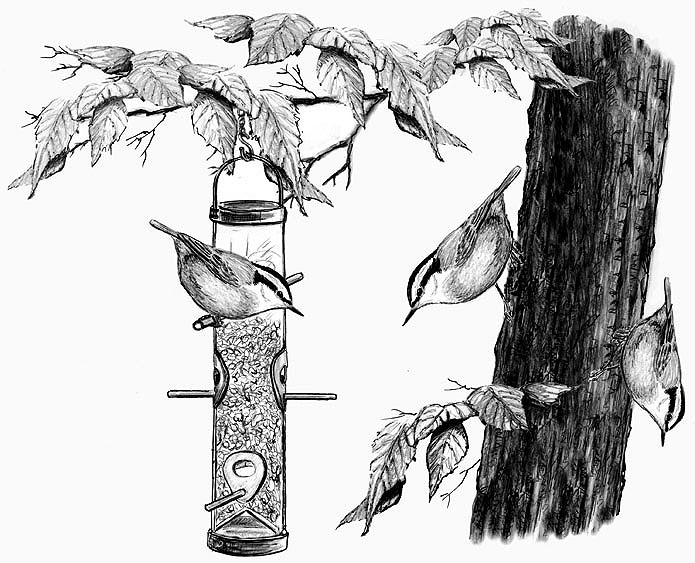
Dear Bird Folks,
We often have nuthatches in our yard. I know when they are around because I can hear their signature, “yank, yank, yank” call. Today I heard what sounded like baby White-breasted Nuthatches, but after a closer look they turned out to be Red-breasted Nuthatches. I haven’t seen them around here before. Are they new to the area or have I not been paying attention?
– Martin, Sandwich, MA
Come on, Martin,
I’m happy that you saw your first Red-breasted Nuthatches and everything, but I wish you had picked a different bird to ask me about. I like Red-breasted Nuthatches as much as the next person but it’s the bird’s name that I hate. Couldn’t you have asked me about a Mallard, or a Killdeer or some other bird with a shorter name? Why did you have to pick a name with twenty characters in it? That’s a lot of extra typing. And don’t get me started on the hyphen. My fingers aren’t meant to type that little line. Every time I try to use a hyphen, I mistakenly hit the equal sign, so the bird ends up being a Red=breasted Nuthatch. The next time you ask a question please think of me and my hyphen issues. I’d appreciate it.
Red=breasted Nuthatches are cute little birds, with “little” being the key word. They are smaller than chickadees and about half the size of a titmouse. They have gray backs, with black caps and distinctive white eye stripes. But ironically, what they don’t have is a bright red breast. The male Rose=breasted Grosbeak truly has a red breast, but not this bird. Its breast is more of a soft rusty/orange wash. It fact, they originally wanted to call it the “Soft rusty/orange wash=breasted Nuthatch,” but they knew such a long name would have put me over the edge, so they went with red instead. Whew!
Red-breasted Nuthatches (hey, I wrote it right!) can be found on Cape Cod every day of the year, but fall is the best time to look for them, and some falls are better than others. The vast majority of these birds breed in northern U. S. and in Canada, with many of them moving south in the winter. Some winters we see very few of these birds, but then there are other years when it seems we are neck deep in nuthatches. A mass migration is most likely caused by lack of food. Every couple of years the northern pinecone crop crashes, leaving many birds with little to eat. Don’t worry, seed shortages are a naturally occurring event and are not caused by man’s negligence or by space aliens. Trees need to keep the population of the seedeaters in check so some years they produce very few seeds. When that happens many terrestrial seedeaters go hungry, while the avian seedeaters clear out and head south. The influx of thousands of northern seed-eating birds creates great excitement for those folks who watch birds and even greater excitement for those who sell birdseed. Yeah, baby!!
Migrating Red-breasted Nuthatches are fascinating because the majority of them have had little exposure to bird birdfeeders, or even humans, for that matter. Yet, when they discover a birdfeeder, for perhaps the very first time ever, they show little fear or trepidation and readily eat from it. I guess, when in Rome… Or in this case, when in Sandwich…
Another interesting oddity about these nuthatches is that they love our feeders, but hate our birdhouses. Even though they are cavity nesters, just like chickadees and bluebirds, they will rarely build a nest in anything that they don’t make themselves. They avoid birdhouses and instead hollow out a cavity in the trunk of a rotting tree. The female does most of the excavation, but the male is always close by to provide her with snacks and to tell her what she is doing wrong.
A unique feature of a Red-breasted Nuthatch’s home is that they cover the outside of the entrance hole with fresh, sticky tree sap. Yes, tree sap. In a possible effort to deter predators or tax assessors, the birds carry globs of sap in their beaks and paint it around the entrance hole. Interestingly, some birds don’t like getting the sap on their beaks and instead apply it with a piece of bark. Really. This behavior clearly shows that these little nuthatches have the ability to use tools and also, that even birds can be annoyingly prissy.
Red-breasted Nuthatches may be tiny birds, but they are brimming with confidence. They’ll readily come to a feeder and aren’t intimidated by any other feeding bird, no matter the size. They also aren’t afraid of one of nature’s most sinister creatures, humans. The next time you see Red-breasted Nuthatches in your yard, walk up to them. They don’t care. You may be a big deal in the world of people but you won’t impress them in the least.